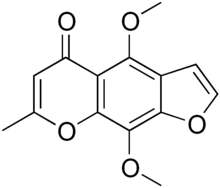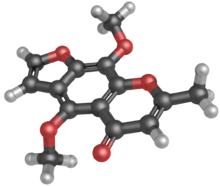خلين

| |

| |
| الأسماء | |
|---|---|
| اسم أيوپاك المفضل
4,9-Dimethoxy-7-methyl-5H-furo[3,2-g][1]benzopyran-5-one | |
| أسماء أخرى
Amicardine; Corafurone; Methafrone; Kelourin; Rykellin; Visammin ; Ammispasmin; Ammivisnagen; Gynokhellan; Interkellin; Interkhellin; Amikellin; Ammipuran; Benecardin; Deltoside; Kelicorin; Khelangin; Khellamine; Khellanals; Khellinorm; Medekellin; Visammimix; Viscardan; Visnagalin; Kalangin; Kelincor
| |
| المُعرِّفات | |
| رقم CAS | |
3D model (JSmol)
|
|
| ChEMBL | |
| ChemSpider | |
| ECHA InfoCard | 100.001.267 |
| رقم EC |
|
| KEGG | |
| عناوين مواضيع طبية MeSH | |
PubChem CID
|
|
| UNII | |
CompTox Dashboard (EPA)
|
|
| |
| |
| الخصائص | |
| الصيغة الجزيئية | C14H12O5 |
| كتلة مولية | 260.22 g mol-1 |
| المظهر | colorless needle-shaped crystals |
| نقطة الانصهار | |
ما لم يُذكر غير ذلك، البيانات المعطاة للمواد في حالاتهم العيارية (عند 25 °س [77 °ف]، 100 kPa). | |
| مراجع الجدول | |
خلين Khellin يُستعمل كطب شعبي عشبي، يعود في حوض المتوسط إلى مصر القديمة، لعلاج مجموعة متنوعة من الأمراض، منها: المغص الكلوي، حصى الكلى، مرض الشريان التاجي، الربو الشعبي، البهاق، و الصدفية.[1] وهو مكون رئيسي في نبات الخلة البلدية، المعروف أيضاً بإسم Bishop's Weed. وبمجرد تنقيته، يتواجد الخلين على شكل بلورات إبرية الشكل مُرّة المذاق عديمة الرائحة واللون[2] ويُصنف على أنه گاما-پايرون، أحد مشتقات الفورانوكرومون. في مطلع القرن العشرين، بحث العلماء عن مضاهيات للخلين بدرجة سمية أقل وفعالية أفضل. فاكتشفوا عدداً من الأدوية، من خلال هذا البحث، مثل أميودارون و كرومولين صوديوم، اللذين يُستخدمان في الممارسات الطبية الحالية. إفلوكسات Efloxate هو أيضاً مذكور كمضاهي.[3]
خلفية
Khellin is found in Egypt, the Middle East, and areas surrounding the Mediterranean. It is a major constituent of the plant Ammi Visnaga, existing between 0.3 and 1.2% in the leaves and seeds.[4] Bishop's Weed is a name given to several species of plants; however, only Ammi Visnaga contains khellin. Khellin is rarely found in its pure form; instead it is found in Ammi Visnaga or "Khella" extract. As a result, many healing properties have been attributed to Khellin that are actually due to other constituents in the extract. Ammi Visnaga preparations are commercially available and very common; however, the amount of Khellin and other ingredients varies greatly between brands and even batches of the same brand. The extract is commonly found as a tea or in a pill form.
الاستخدامات الطبية
Therapeutic use is often not recommended, as the risks often outweigh the benefits. Regardless of this recommendation, Ammi Visnaga is still often used in the Middle East, Egypt, and surrounding areas. Unwanted side effects include dizziness, reversible cholestatic jaundice, pseudoallergic reaction, and elevated levels of liver enzymes (transaminases and gamma-glutamyltransferase).[5]
البهاق
Vitiligo is a disease which causes loss of pigmentation in portions of skin. When khellin is applied topically in combination with UVA light, it is able to stimulate melanocytes (cells that produce melanin) in hair follicles for successful treatment of vitiligo. One such method is blister roof transplantation; in which, blisters are formed on an unaffected area and are then grafted onto a vitiligo affected area. When khellin is applied topically and treated with UV light, pigmentation returns to treated areas.[6] When taken systemically, khellin induces elevated liver enzyme levels and broad photosensitivity; however, topical application reduces these side effects. Psoralens are commonly used for vitiligo treatment, but have higher phototoxic and DNA mutagenic effects. While Khellin treatment in conjunction with UV therapy is successful, accelerated photoaging and increased risk of skin cancer is another concern.[7]
حصوات الكلى
When ammi visnaga extract is taken daily, as a tea or as a pill, calcium oxalate kidney stone formation is inhibited, making it a good treatment for hyperoxaluria (a condition in which there is excessive oxalate excretion in the urine, causing kidney stones). Khellin was thought to slow or prevent calcium oxalate nucleation, preventing stones from forming. However, studies have shown that khellin is not the active ingredient in Ammi Visnaga extract. Upon studying calcium oxalate nucleation, ammi visnaga extract as a whole was shown to prolong nucleation time as well as change stone conformation, while khellin alone had no effect.[8][9]
Khellin has also been used to treat renal colic, which is due mostly to schistosomiasis infections and stone formation. The plant mixture had diuretic properties that were seen to relieve renal colic by relaxing the ureter and acting as a diuretic.
غيرهم
Intramuscular injections of khellin can also be used to treat asthma. Khellin acts as a bronchodilator; however, the common side effects including nausea present difficulties.[10]
Khellin has been used to relieve the pain associated with angina pectoris by acting as a selective coronary vasodilator.[11] This can be done either orally or intramuscularly; however nausea is a major side effect regardless of how the medication is taken.[12]
انظر أيضاً
- Ammi (plant)
- Amikhelline, an antimitotic drug
- Visnagin
المراجع
- ^ Azim Khan, Muhammad (2014). "Phytochemistry and Medicinal Properties of Ammi Visnaga". Pak. J. Bot. 46 (3): 861–867.
- ^ Shinde, P B; Laddha, K S (March 2014). "Development of new isolation technique and validated HPLC method development for khellin". Indian Journal of Natural Products and Resources. 5 (1): 40–43.
- ^ Dewar, H. A.; Horler, A. R.; Newell, D. J. (1959). "A Clinical Trial of Penta-Erythritol Tetranitrate, A Khellin Derivative (Recordil), and Iproniazid in Angina of Effort". Heart. 21 (3): 315–322. doi:10.1136/hrt.21.3.315. ISSN 1355-6037. PMC 1017586. PMID 13816307.
- ^ Mesbah, M.K. (1992). "Determination of Khellin and Visnagin in Ammi visnaga fruits and in renal teas by HPLC". Egypt. J. Pharm. Sci. 33 (5–6): 897–904.
- ^ Blumenthal, M; Busse, W.R.; Goldberg, A.; Gruenwald, J.; Hall, T.; Riggins, C.W.; Rister, R.S (1998). The complete German commission monographs, therapeutic guide to herbal medicines.
- ^ Leeuw, J de; Assen, YJ; Bjerring, P; Neumann, HA Martino (2011). "Treatment of vitiligo with khellin liposomes, UV light and blister roof transplantation". J Eur Acad Dermatol Venereol. 25 (1): 74–81. doi:10.1111/j.1468-3083.2010.03701.x. PMID 20477914.
- ^ Plettenberg, Heidi; Assmann, Till; Ruzicka, Thomas (2003). "Childhood vitiligo and tacrolimus". Arch. Dermatol. 139 (5): 651–654. doi:10.1001/archderm.139.5.651. PMID 12756103.
- ^ Vanachayangkul, P.; Chow, N.; Khan, S. R.; Butterweck, Veronika (2011). "Prevention of renal crystal deposition by an extract of Ammi visnaga L. and its constituents khellin and visnagin in hyperoxaluric rats". Urol. Res. 39 (3): 189–195. doi:10.1007/s00240-010-0333-y. PMC 3663934. PMID 21069311.
- ^ Abdel-Aal, E.A.; Daosukho, S.; El-Shall, H. (2009). "Effect of supersaturation ratio and Khella extract on nucleation and morphology of kidney stones". Journal of Crystal Growth. 311 (9): 2673–2681. doi:10.1016/j.jcrysgro.2009.02.027.
- ^ Kennedy, M.C.S; Stock, J.P.P (1952). "The bronchodilator action of khellin". Thorax. 7 (1): 43–65. doi:10.1136/thx.7.1.43. PMC 1019140. PMID 14913500.
- ^ Osher, Harold; Katz, Kermit; Wagner, Donald (1951). "Khellin in the treatment of angina pectoris". The New England Journal of Medicine. 244 (9): 315–321. doi:10.1056/nejm195103012440901. PMID 14806755.
- ^ Conn, James J. (1952). "The treatment of angina pectoris with khellin". Annals of Internal Medicine. 36 (5): 1173–1178. doi:10.7326/0003-4819-36-5-1173. PMID 14924454.
وصلات خارجية
- Articles with changed EBI identifier
- Articles with changed ChemSpider identifier
- ECHA InfoCard ID from Wikidata
- Articles with changed KEGG identifier
- Articles with changed FDA identifier
- Articles with changed InChI identifier
- Articles containing unverified chemical infoboxes
- Short description is different from Wikidata
- فورانوكرومونات
- Hydroxyquinol ethers
- Benzofuran ethers at the benzene ring